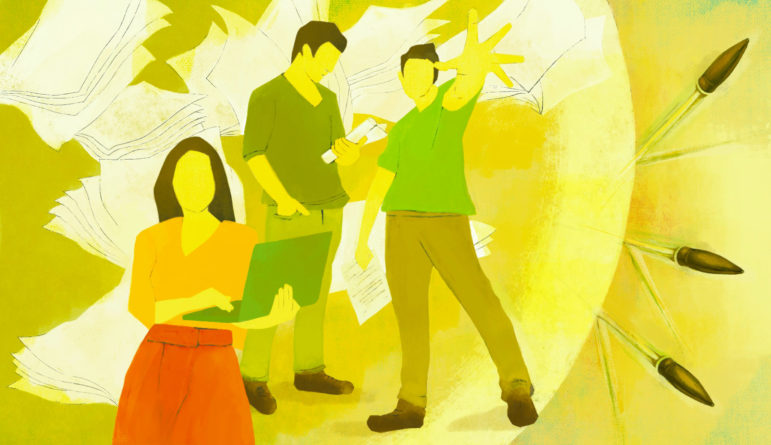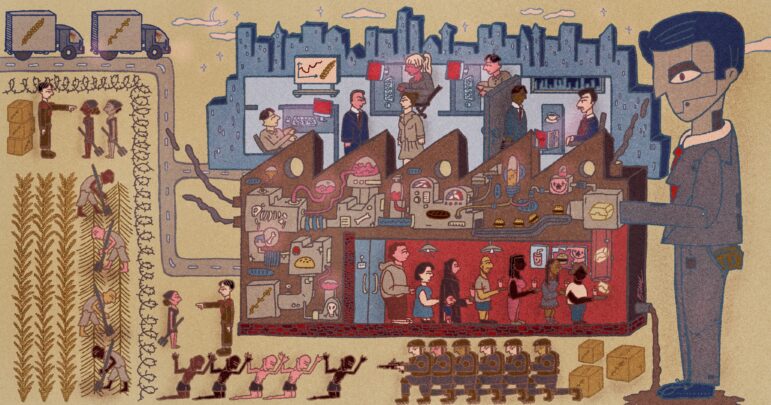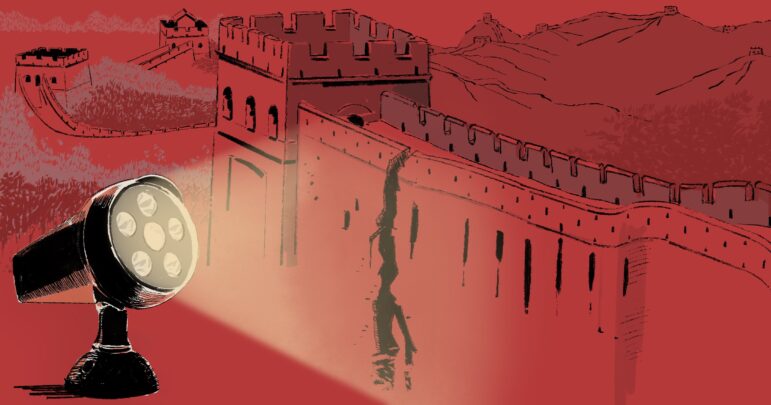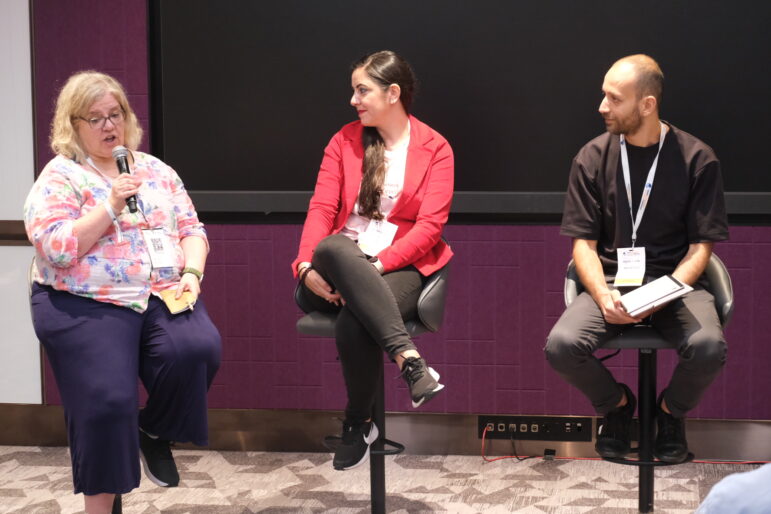

Illustration: Smaranda Tolosano for GIJN
Introduction to Investigative Journalism: Fact-Checking
Read this article in
Guide Resource
Guide: Introduction to Investigative Journalism
Chapter Guide Resource
Introduction to Investigative Journalism
Chapter Guide Resource
Introduction to Investigative Journalism: Interviewing Techniques for Beginners
Chapter Guide Resource
Introduction to Investigative Journalism: Following the Money
Chapter Guide Resource
Introduction to Investigative Journalism: Data Journalism
Chapter Guide Resource
Introduction to Investigative Journalism: Fact-Checking
Chapter Guide Resource
Introduction to Investigative Journalism: Digital Security
Chapter Guide Resource
Introduction to Investigative Journalism: Collaborations
Chapter Guide Resource
Introduction to Investigative Journalism: Editing: The Investigative Article
So you have a story draft ready. Now what?
You’ve been hard at work on your story, researching and reporting it for several weeks — or even months. You and your editor have finally agreed on a draft. Now comes the seemingly daunting task of fact-checking — making sure every statement in your piece holds up to scrutiny.
But without the right tools to stay organized from the very beginning of your research, and a deliberate process ingrained in your reporting to track your source materials, it can be nearly impossible to fact-check your story.
However, it doesn’t have to be so hard. This chapter lays out how to develop a process that will make it smooth, even easy.
Here, we will focus on the practice of fact-checking one’s own story or a colleague’s within the newsroom and before publication or the airing of the piece — what’s known as internal pre-publication fact-checking. What this chapter does not cover is the external or independent fact-checking that happens, for example, when outlets like Politifact, FactCheck.org, Reuters Fact Check, the African Fact-Checking Alliance, or FactChecker.in debunk disinformation on social media sites or elsewhere. (For a more detailed look at this topic, see GIJN’s Guide to Fact-Checking Investigative Stories.)
Fact-Checking Today
In the “Chicago Guide to Fact-Checking”, author Brooke Borel quoted the head of Vanity Fair magazine’s research department, John Banta, who summarized the role of the fact-checker: “We provide a service where we go in and take everything apart — we take out the engine out of the car, throw the parts on the floor, and put it back together again.”
Fact-checking takes apart the reporting to ensure it is solid, accurate, and fair, a critical task in newsrooms that was far more widespread decades ago, when news magazines typically had fact-checkers on staff.
Today, however, full-time fact-checkers in newsrooms are rare, mainly because budgets have shrunk over the past few decades and newsrooms can’t afford them anymore. That said, some news magazines still have fact-checking departments, such as The New Yorker. Other US news magazines fact-check by using whatever resources they have: For example, at The Nation, their rotating but robust group of interns are tasked with fact-checking. Still, it’s far more common in newsrooms these days to find reporters solely responsible for fact-checking their own stories, with the legal department having the last word.
Whoever performs the functions of fact-checking — a freelance fact-checker, a member of an investigative project team, or the reporter themselves — usually employs a timeline with certain steps. If, for example, you work in a newsroom with a fact-checker, the process might go something like this: When you have a draft ready, you share it with the fact-checker, along with your sources, notes, and anything else you used to report the story. Unless the newsroom follows the “magazine-style” fact-check in which every single statement of fact is verified, the fact-checker may talk to the reporter to discuss which sections of the story should be reviewed, and how.
Once the fact-check of the story is complete, the fact-checker will report the changes they deem necessary with their reasoning for the changes, and the story editors can decide what changes are appropriate. Afterward, the final draft moves to the legal department (or sometimes, the legal department may review the draft before the fact-check is finalized), and then to the copy desk before being published.
Regardless of whether it’s done by the reporter or someone else, every investigation absolutely must be fact-checked. Why is it so important? In her book, Borel puts it simply: “Between all the reading, interviewing, and thinking, the foundation may crack and crumble. Maybe the problem is minimal – a simple misunderstanding or copy error… If the crack is small and the remaining sources are solid, the story could survive. Still, it’s a crack, and an observant reader starts to wonder about the rest of the story.”
If enough of these small cracks appear in your work, they could erode the credibility of the piece and the trust of your readers – even more so if these errors involve misquoting a source or failing to provide the necessary context for a quote.
However, given how rare it is to have your own work fact-checked by an in-house fact-checker, we’ll review how to proof your investigative stories with the same rigor as a newsroom staff fact-checker.
Tips and Tools
Stay Organized
The most important thing you can do to make the fact-checking process easy is to set up a consistent organizational system for yourself. Develop one you feel comfortable with – by using Dropbox, Google Drive, or simply your own computer’s hard drive (but make sure you have a backup drive) – and set up your folders using easy-to-recognize naming conventions for them. If you’re working with a team, make sure to discuss with its other members how you plan to organize the collaborative work, and agree to stay consistent. Set up a contact sheet for each source you speak with, document when you have spoken to them, and create a dedicated folder for the recordings of interviews.
Even before you have a solid idea of where your story is going, setting up a system and sticking to it is crucial. My former colleague, archivist Talya Cooper also has many great tips for organizing your reporting, especially for dealing with sensitive material.
Annotate Your Story
Annotating is key to ensuring that you can easily back up each statement of fact.
As you work on your draft, note where each statement of fact came from. There are a number of ways to do this, but my personal preference is using footnotes to document the sourcing after each sentence. Some journalists run their stories through a text editor and separate each statement of fact into a spreadsheet, with one column for each statement of fact, and the following columns indicating its sourcing, including links, filenames, and audio timecodes.
Make sure you stay consistent. Your system of storing and organizing your material will be key to making sure that annotating will be straightforward, and that someone who is unfamiliar with the draft can easily discern the source of each fact.
Make Sure Your Sourcing Is Solid
To help your fact-checking, make sure the sources you are relying on are reliable, fair, and accurate.
As you report, you will be drawing significantly from primary sources, including (but certainly not limited to): documents and datasets from government agencies; archival material; court records; interviews; and press releases. Do not rely on social media or blog posts that don’t cite the source of their information.
Wikipedia can be a good resource when first starting to research your story. However, it is not a reliable or acceptable source to cite because anyone can edit a page and add in information without sourcing it.
Meanwhile, artificial intelligence apps like ChatGPT are emerging as commonly used tools, but they are unreliable. In 2023, a lawyer representing a plaintiff in an aviation civil suit in the US used ChatGPT to prepare a brief. As Benjamin Weiser for The New York Times reported: “There was just one hitch: No one – not the airline’s lawyers, not even the judge himself – could find the decisions or the quotations cited and summarized in the brief. That was because ChatGPT had invented everything.”
Save Your Links

The Wayback Machine can be a vital tool for fact-checking old webpages. Image: Shutterstock
In addition to documents, public records, and source interviews, you may use source material you find online. Because webpages, articles, and social media posts can be taken down or changed in an instant, it’s important to not only save the links but also archive them in case they no longer work. The Wayback Machine is an essential tool for this and it’s also a great way to access archived versions of old webpages: It’s possible to go back to various points in time to see how a webpage may have looked years or even decades ago. If you want to save a social media post you find on X (formerly Twitter), for example, you can save it in archive.is.
Critical Fact-Checking Questions
During my first full-time fact-checking job at The Intercept, the former fact-checking desk developed a set of guidelines that I would refer to regularly whenever I was checking a fact that didn’t have adequate sourcing, or if the sourcing didn’t necessarily confirm the statement. At those moments, my fellow fact-checkers and I would ask ourselves the following questions:
- Can we say with confidence that this statement is true?
- Can we present evidence that would compel a skeptic to share my confidence?
- Can we conceive of a realistic scenario in which I’m presented with counter-evidence that would compel my publication to run a correction?
If it turned out that we couldn’t answer one of these questions with confidence, then we would know to find other sourcing or suggest alternate wording to the reporter. When fact-checking your own work, keep these questions in mind.
Fact-Checking Priorities
While it’s critical to make sure every statement of fact in your story is correct, it’s just as important to recognize what type of facts might draw the most scrutiny if they end up being incorrect. This is a handy list of what to prioritize.
- Statements that disparage a person or organization, anything that could be considered libelous;
- Technical or financial information, especially if not previously reported;
- Summaries of scholarly studies;
- Descriptions of legal arguments (review documents from both sides of a case);
- Statistics, casualty figures, and other numerical data;
- Dates and chronology of events;
- Statistical or other analysis performed by the reporter;
- Descriptions or summaries of official policies or laws;
- Descriptions of someone else’s reporting;
- Formal name spellings;
- Descriptions of well-known historical events;
- Sweeping statements and superlatives: “One of the highest rates of…”;
- Biographical information received via interviews.
Avoid Common Errors
When a fact-checker is asked what type of errors they most frequently encounter, they usually say those that occur when journalists write from memory. These errors involve several common issues.
- Names and titles: It’s easy to mix up corporate executive titles like Chairman or CEO, for instance;
- Superlatives: For example, if you want to say, “Hurricane Beryl was the worst hurricane on record.” How was it “the worst”? In terms of the category of storm it falls into? In terms of number of fatalities? It’s good to be more specific rather than rely on superlatives;
- Contextual information: Dates, times, locations;
- Numerical figures and statistics;
- Quotations.
With anything you think you know, check it anyway. Human memory easily fails even the most experienced of journalists. It’s not uncommon that a reporter may misremember what year a certain law was enacted or what the title of a corporate executive may have been. Don’t rely on memory as a source, always double-check.
Better Journalists, Better Stories
To sum up the key takeaways in this guide: Set up a system to make sure you can easily pull up material you’ve used, and annotate your draft as you work on it. Don’t rely on memory. Check and double-check.
It’s these habits that will help ingrain fact-checking to become an integral part of your reporting process. That, in turn, will help make you a better journalist and your investigations more credible and impactful.
Margot Williams contributed to this chapter.
 Mariam Elba is a news researcher based in New York. She is currently at ProPublica where she is a research reporter supporting local investigations in the US. She was previously an associate research editor at The Intercept where she led the fact-checking desk.
Mariam Elba is a news researcher based in New York. She is currently at ProPublica where she is a research reporter supporting local investigations in the US. She was previously an associate research editor at The Intercept where she led the fact-checking desk.
 Margot Williams is Research Editor for Investigations at The Intercept. She has also worked at The New York Times, NPR, the International Consortium of Investigative Journalists, and The Washington Post, where during 14 years at the newspaper was a member of two Pulitzer Prize-winning teams, for a 1998 investigation of Washington, DC police shootings of civilians and a 2001 prize for national coverage of terrorism.
Margot Williams is Research Editor for Investigations at The Intercept. She has also worked at The New York Times, NPR, the International Consortium of Investigative Journalists, and The Washington Post, where during 14 years at the newspaper was a member of two Pulitzer Prize-winning teams, for a 1998 investigation of Washington, DC police shootings of civilians and a 2001 prize for national coverage of terrorism.




















